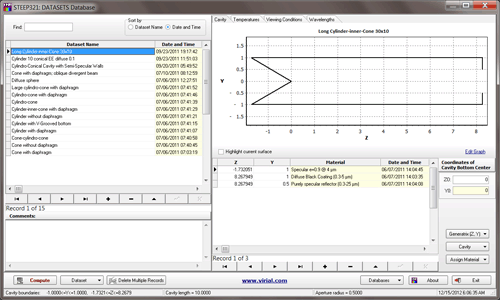STEEP321 is the program for Monte Carlo calculations of radiation characteristics of axisymmetric blackbodies. STEEP321 uses the Uniform Specular-Diffuse (USD) model of reflection. This is a simple but powerful blackbody modeling tool allowing to calculate entire spectral effective emissivity curve at one run, to model isothermal and nonisothermal cavities, to change incrementally parameters of viewing conditions, to take into account background radiation, and many more. For details, see STEEP321 Key Features list, Comparative Table, or download the Manual.
Download STEEP321 Evaluation Version (5 MB)
Download STEEP321 Manual (2.4 MB)
Click here to buy
Download STEEP321 Evaluation Version (5 MB)
Download STEEP321 Manual (2.4 MB)
Click here to buy
STEEP321 doesn't require special efforts for installation. Download the Evaluation Version, unzip it, save STEEP321 folder in the convenient place on the hard drive and run STEEP321.exe. The Evaluation Version has several restrictions (see details in the appropriate Section of the Manual.) After purchasing the product license, you'll receive the activation key which will turn the Evaluation Version into the full-functioned unrestricted program. The Software Licence Agreement is included into the Manual. Go to the Purchase page to see how to buy the license.


STEEP321 is the "wheelhorse" of STEEP3 family. The Uniform Specular-Diffuse (USD) model of reflection provides accuracy more than sufficient for most practical applications. At the same time, due to simplicity of the USD model, results obtained with STEEP321 are easy to undestand and interpret. Simultaneous calculation for up to 8 temperature distributions gives the possibility to evaluate temperature non-uniformity effects quickly.
STEEP321 Key Features
Axially symmetrical cavities can be formed by rotation of polygonal line having up to 1001 vertices
Simultaneous calculation of effective emissivity and radiance temperatures for up to 2001 wavelengths and up to 8 temperature distributions
Up to 1001 temperature points in each temperature distribution
Calculation of total (integrated over the whole spectrum) effective emissivities and radiation temperatures
Five types of viewing conditions (Normal, Directional, Right Conical, Oblique Conical, Integrated)
Consecutive calculations for up to 201 viewing conditions of the same type
Possibility to take into account the contribution of a non-zero background radiation
Built-in expandable databases for:
· Geometrical parameters and temperature distributions
· Optical properties of materials and coatings (Uniform Specular-Diffuse Model of reflection)
· Results of numerical modeling (effective emissivities and radiometric temperatures)
· Geometrical parameters and temperature distributions
· Optical properties of materials and coatings (Uniform Specular-Diffuse Model of reflection)
· Results of numerical modeling (effective emissivities and radiometric temperatures)
Possibility to save tabulated data in text files or as MS Excel spreadsheets
Automatically generated reports in ASCII format
Visualization tools for:
· Cavity scaling cross-section
· Viewing conditions
· Dependence of material’s reflectance on wavelength
· Temperature distributions along cavity generatrix
· Dependences of effective emissivities and radiance temperarures on the wavelength
· Dependences of effective emissivities and radiance temperarures on a variable parameter of viewing conditionsScaling
· Cavity scaling cross-section
· Viewing conditions
· Dependence of material’s reflectance on wavelength
· Temperature distributions along cavity generatrix
· Dependences of effective emissivities and radiance temperarures on the wavelength
· Dependences of effective emissivities and radiance temperarures on a variable parameter of viewing conditionsScaling
Editable, exportable, and printable graphs
Requirements for hardware and software :
· CPU frequency 1 GHz or higher
· Screen Resolution 1280 × 720 or greater
· Hard disk space 20 MB minimum
· RAM 2 MB minimum
· OS MS Windows® 2000/ME/XP/Vista/7/8 (in compatibility mode)
· CPU frequency 1 GHz or higher
· Screen Resolution 1280 × 720 or greater
· Hard disk space 20 MB minimum
· RAM 2 MB minimum
· OS MS Windows® 2000/ME/XP/Vista/7/8 (in compatibility mode)

